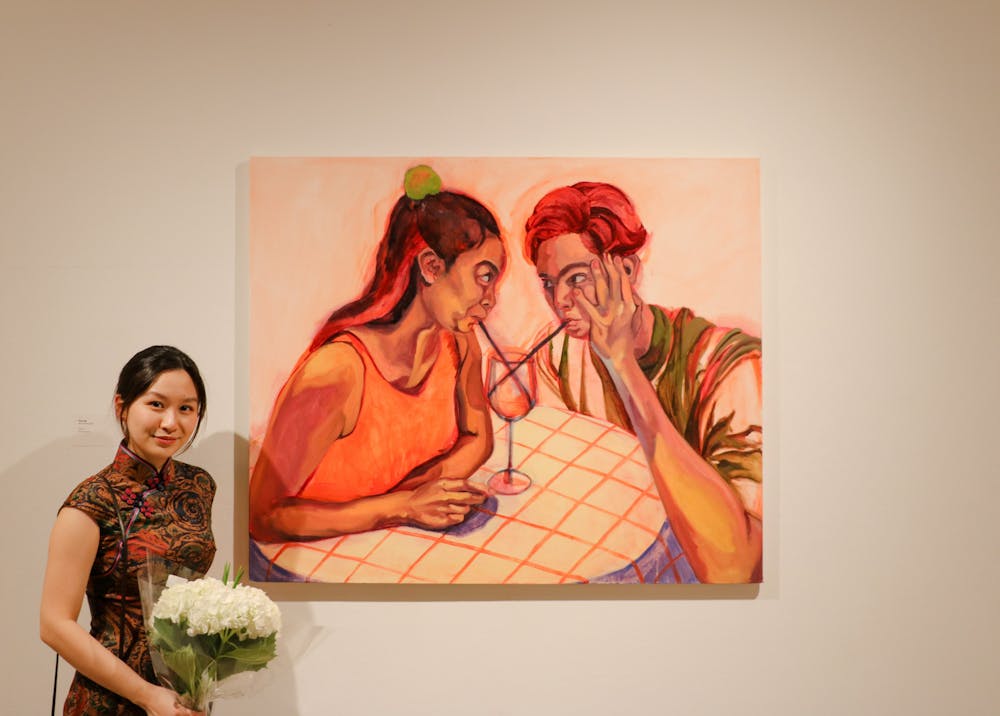One of the first in-person events for the Painting Department at the Rhode Island School of Design since the COVID-19 pandemic began, “Painting 1” celebrates RISD seniors’ artwork while challenging traditional definitions of painting.
Installed at RISD’s Woods-Gerry Gallery, the show — which opened March 4 and ends March 8 — will be followed by another show, “Painting 2,” along with a series of senior exhibits showcasing RISD’s range of disciplines.
For RISD first-year and attendee Avalon Lafosse, the show was “an absolute transportation into a world of vibrancy, color and richness of content.” While each room was different, the works “complemented each other well,” she said.
Viewers at the gallery commented on the diversity of the displayed paintings. Walking around the exhibit’s four rooms, RISD first year Camille Callegari said the show’s diversity comes from the exhibit’s exploration of “mediums beyond paint,” such as cement and concrete.
Several of the seniors whose work was displayed in the gallery told The Herald the show offered an opportunity to reflect on their development as artists throughout their college careers.
Haemin Hwang, a RISD senior whose work was displayed in the show, said that working on canvas can happen “without even painting.”
For India Sachi, another featured RISD senior, painting “comes more naturally” when she is “just putting crazy things together.” The creative process is not always a solitary affair and can include collaboration, she said. In Sachi’s case, she had a friend help her collect wood to paint on.
‘A Big Pink Room and a Cat with Human Eyes’ 2021 by India Sachi
Sachi’s paintings “A Big Pink Room and a Cat with Human Eyes” and “Untitled” emerge from unconventional surfaces — a bedsheet and wood scraps — reflecting the “unexpected qualities” of found materials as exciting alternatives to traditional and often less affordable canvas cloth, she said.
Artists with works in the show developed their language of painting in varied ways, from using materials like textiles to replacing paint with photographs from a Kodak Portra camera. Hwang, whose work examines notions of childhood and the transition into adulthood, also alluded to the process of an artist interacting with the materials they work with.
For Sachi, reflecting on her development as an artist meant revisiting her past interest in weaving themes of identity, immigration and familial history into her work. This focus became limiting, Sachi said. “As an artist of color, it’s an easy box to fall into, and then people really want you to make work about those things,” she said.
Now, instead of confronting generation-defining social issues, she has refocused her work around notions of gaze and girlhood, analyzing what it means to paint as yourself. Sachi said for her that meant reflecting on personal experiences instead of just painting other people’s ideas.
Hwang, who concentrates in computation, technology and culture, compared the information artists communicate to viewers to the process of coding. According to Hwang, she can only control how much information is displayed for viewers of her art, and it is up to the viewers to interpret her art in different ways and create their own narratives.
Recalling a professor’s passing advice, Sachi said her work “will relate to people” whether she knows it or not. Similar to Hwang, Sachi said she welcomes differing interpretations as a testament to the value of making art that ignites creativity.
Given the number of senior painters, there was limited gallery space for each artist, which influenced the selections of pieces. Hwang’s works “Intertwined” and “Untitled” represent her focus on balancing warm and cool colors, she said. When deciding what to put in the show, she specifically “wanted to showcase a more vulnerable sensibility,” reflecting her belief that painting can be an outlet for personal reflections.
Hwang emphasized how she’s making art for a wide range of viewers, not just painters. Referring to her interest in color, she said that not everyone associates the same colors with the same moods that she does.
For the seniors in the show, the exhibit reflects a three-year process of rigorous experimentation and celebrates their maturing creative sensibility. Despite the exhibit representing a culmination of four years at RISD, Sachi said she is still very much “learning as an artist.”
With a busy opening reception, attendees showed differing interests in the wide array of art on display, ranging from laughs at long, sardonic titles to appreciation for complex character designs.
When asked about her process, Sachi mentioned that her works are a result of a creative process involving printer paper, glue and canvas, embodied by an attitude of “whatever sticks remains” and whatever falls off is gone.
She said she finished her painting “A Big Pink Room and a Cat with Human Eyes” the night before its display — it was “definitely still wet,” she said.
Still, despite the fact that her paintings are not created with the intention of preservation due to her non-archival process, Sachi said she believes “paintings should just disintegrate like everything else, and I think that they’ll be beautiful still.”





